this list is steamlined from the others, to simply shows the audio interfaces that feature BNC word clock in&out (hiding those that dont feature word clock)
this feature is important for maintaining sync between audio interfaces when using aggregate setups (combinations of devices summed to provide more comprehensive i/o) it might be argued that this is a professional feature reserved for devices that woudl most likely be used in multi-setups with more i/o provided from using multiple interfaces simultaneously
motu 828 mkII (2004)

connects via firewire | mkII has added features: MIDI I/O, word clock support and SMPTE sync. (not included on original version)
http://www.soundonsound.com/sos/jul04/articles/motu828mkii.htmmanual:
http://cdn-data.motu.com/manuals/firewire-usb-audio/828mkII_Manual_Mac.pdfNote that the 828 MkII has been designed to allow you to use multiple units together, but whether this is possible depends on the operating system of the host computer and/or the audio software you're working with.
M-audio Delta 1010 (2000)

manual:
http://www.m-audio.ca/images/global/manuals/070208_Delta1010_UG_EN01.pdfconnects via PCI | allows use of m-powered 6.8+ on mac osx
more info:
http://www.soundonsound.com/sos/jan00/articles/midiman1010.htm2 notches in pci card denotes powermac g5 compatibility | 1 notch means g3/g4 compatible only
can be combined with up to 3 other delta cards to add addtional i/o
lacks compatibility with rca or xlr jacks, no mic preamps
M-audio Delta 1010LT (2001)

2 notches in pci card denotes powermac g5 compatibility | 1 notch means g3/g4 compatible only
can be combined with up to 3 other delta cards to add addtional i/o
features 2 mic preamps but no 1/4" instr. jack compatibility
edirol da-2496 (2002)
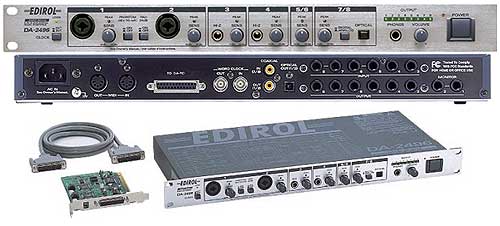

connects via its PCI card the "DA-PCI"
larger image:
http://medias.audiofanzine.com/images/normal/edirol-da-2496-640408.jpgmore info:
http://www.soundonsound.com/sos/aug02/articles/edirolda2496.aspmanual:
http://lib.roland.co.jp/support/en/manuals/res/1811338/DA2496_s_e1.pdfdrivers:
http://www.roland.com/support/article/?q=downloads&p=DA-2496&id=1812652drivers range from win98-windowsXP for pc | os9-osx for mac
the pci card ("DA-PCI") that this interface attaches to i have read is identical to a "Roland RPC-1"
which a pci card that can be used as an interface as well
 http://homerecording.com/bbs/general-discussions/digital-recording-computers/delta-1010lt-edirol-da-2496-a-204693/tascam fw1804
http://homerecording.com/bbs/general-discussions/digital-recording-computers/delta-1010lt-edirol-da-2496-a-204693/tascam fw1804 (2006)


more info:
http://www.soundonsound.com/sos/jan06/articles/tascamfw1804.htmdriver:
http://tascam.com/content/downloads/products/309/fw1804_os9_1_4_0.hqxmanual:
http://tascam.com/content/downloads/products/309/FW-1804_OM_Eng_web.pdfconnects via firewire | possibly the last device produced by tascam to support os9?
m-audio firewire 1814 (2004)

info:
http://www.soundonsound.com/sos/Oct04/articles/maudio1814.htmconnects via firewire | allows use of m-powered 7+ software under osx | NOT BUS POWERED requires 12v dc powersupply
manual:
http://www.m-audio.ca/images/global/manuals/FireWire-1814_Manual.pdfTascam FW1884 (2003)
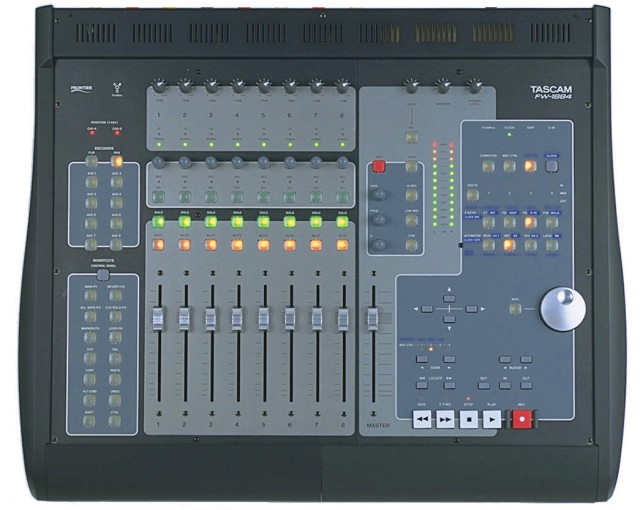

driver:
http://tascam.com/content/downloads/products/229/fw1884_os9_1_2_0.hqxmanual:
http://tascam.com/content/downloads/products/229/fw1884_manual_e_1_00.pdfinfo :
http://tascam.com/product/fw-1884/overview/more info:
http://www.soundonsound.com/sos/nov03/articles/tascamfw1884.htmyamaha dm 1000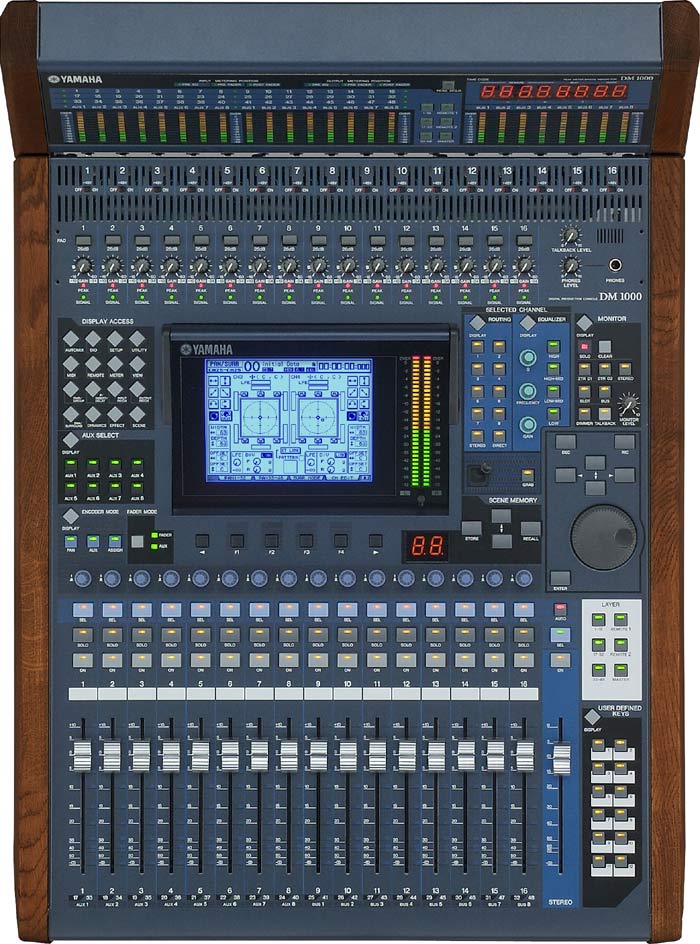

rear;
http://www.yamahacommercialaudiosystems.com/images/photo_lib/DM1000_sp_rear.jpgmore info:
http://www.soundonsound.com/sos/jan04/articles/yamahadm1000.htmvideo:
http://www.youtube.com/watch?v=V9q5VSrgdCIecho layla 20bit 1999

mac os 9 driver?
echo layla 24 (2002?)

driver:
http://files.echoaudio.com/drivers/mac/install_echo24_6.04.hqxmore info:
http://www.soundonsound.com/sos/jun02/articles/echolaptop.aspecho mona (2002?)

driver:
http://files.echoaudio.com/drivers/mac/install_echo24_6.04.hqxmore info:
http://www.soundonsound.com/sos/oct00/articles/echo.htmpresonus firestation (2003)



manual:
http://web.archive.org/web/20040528111816/http://www.presonus.com/pdf/firestation_manual.pdffront outline:
http://web.archive.org/web/20071005110147/http://www.presonus.com/images/diagram_large_front_firestation.gifrear outline:
http://web.archive.org/web/20041028144958/http://www.presonus.com/images/diagram_large_back_firestation.gifinstall guide:
http://www.presonus.com/uploads/products/1144/downloads/FIREstation_Quick_Start_Mac_EN.pdfmore info:
http://www.soundonsound.com/sos/feb03/articles/presonusfirestation.aspmanual:
http://www.presonus.com/uploads/products/1144/downloads/FIREstation_Owners_Manual_EN.pdfdriver:
http://web.archive.org/web/20040528111816/http://www.presonus.com/drivers/drivers_macos.sitthe firestation can be used as an adat slave much like the behringer ada8000 adat unit to attach to the Digi 001, Digi 002, or other interfaces that feature Adat expansion
The FIREstation is designed for use with Windows XP and Macintosh
OS 9.x. Other operating systems are not currently supported by
Presonus or Yamaha
korg 1212 pci (1997)


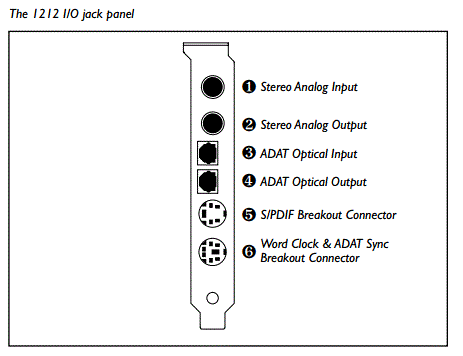 http://webcache.googleusercontent.com/search?q=cache:5sjXRYkzHo0J:www.korg.com/uploads/Support/english_633661595520240000.pdf+&cd=1&hl=en&ct=clnk&gl=ca&client=firefox-ahttp://www.soundonsound.com/sos/1997_articles/jul97/korg1212.html
http://webcache.googleusercontent.com/search?q=cache:5sjXRYkzHo0J:www.korg.com/uploads/Support/english_633661595520240000.pdf+&cd=1&hl=en&ct=clnk&gl=ca&client=firefox-ahttp://www.soundonsound.com/sos/1997_articles/jul97/korg1212.htmlmanual:
http://www.korg.com/uploads/Support/english_633661595520240000.pdfconnects via pci | S/PDIF, stereo analog i/o +4/-10 | ADAT i/o | word clock bnc | Adat sync
RME multiface (2003)


DRIVER: http://www.rme-audio.de/download/treiber_archiv/m9652_161.sit
http://www.rme-audio.de/old/english/hdsp/multifa.htm
part of the hammerfall serise & connects via pci or cardbus card (more info : http://www.rme-audio.de/old/english/hdsp/cardpci.htm)
8 x analog line I/O, 96 kHz/24 bit, SNR 111 dBA, 1/4" TRS jacks
1 x ADAT digital I/O
1 x SPDIF digital I/O
1 x Word clock I/O (BNC)
1 x hi-power analog line/headphone output, separate output for independent submix
1 x MIDI I/O, 16 channels high-speed MIDI
Hardware level calculation: freely scalable level meters, peak and RMS calculation without CPU load
TotalMix: 720 channel mixer with 40 bit internal resolution. MIDI remote controllable.
S/MUX poured in hardware: 4 channels 96 kHz/24 bit for record and playback via ADAT optical
RME digiface

 http://www.rme-audio.de/old/english/hdsp/digifa.htmRME Hammerfall DSP 9652
http://www.rme-audio.de/old/english/hdsp/digifa.htmRME Hammerfall DSP 9652 (2003)
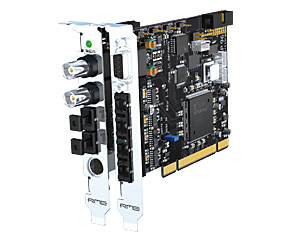 http://www.soundonsound.com/sos/sep99/articles/rmehammer.htmhttp://www.soundonsound.com/sos/jul03/articles/rmehammerfall.asphttp://www.rme-audio.de/en_products_hdsp_9652.phphttp://www.rme-audio.de/en_downloads_driver_archive.phphttp://www.rme-audio.de/download/treiber_archiv/m96_16.sithttp://www.rme-audio.de/download/treiber_archiv/m9652_161.sit
http://www.soundonsound.com/sos/sep99/articles/rmehammer.htmhttp://www.soundonsound.com/sos/jul03/articles/rmehammerfall.asphttp://www.rme-audio.de/en_products_hdsp_9652.phphttp://www.rme-audio.de/en_downloads_driver_archive.phphttp://www.rme-audio.de/download/treiber_archiv/m96_16.sithttp://www.rme-audio.de/download/treiber_archiv/m9652_161.sitAs in the original Hammerfall, the 9652 product number refers to the fact that the card supports sampling rates up to 96kHz and audio inputs and outputs for up to 52 channels — 26 inputs and 26 outputs, from three ADAT I/O pairs and co-axial S/PDIF I/O. Each ADAT channel supports 48kHz/24-bit operation, and S/MUX mode is also available to pair ADAT channels in order to provide 12 96kHz/24-bit channels instead. Like its predecessor, the HDSP 9652 also implements what RME refer to as 'ASIO zero CPU load' technology, meaning that you can have 52-channel operation without placing any burden on the host processor.
NUENDO AUDIOLINK 96 (2002)
 http://www.soundonsound.com/sos/sep02/articles/audiolink.asp
http://www.soundonsound.com/sos/sep02/articles/audiolink.aspThe Nuendo Audiolink 96 system is no longer distributed by Steinberg since 2004. We recommend all users to get current drivers, tools and manuals directly from the hardware manufacturer RME-Audio. RME-Audio lists this card under the category "Hammerfall DSP" as "Digiface" and "Multiface".
motu 896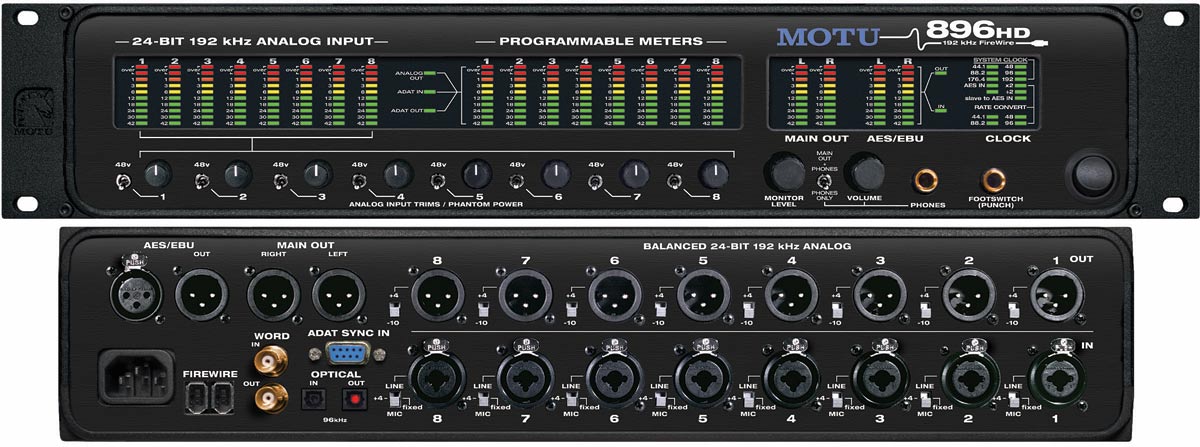
more info:
http://www.soundonsound.com/sos/jul02/articles/motu896.asp
wordclock compatible
 motu 1224
motu 1224
connects via 324 PCI card | can combine with the 2408 + other motu systems
driver download :
http://cdn-data.motu.com/downloads/pci424/pci_os9.hqxContains audio drivers and application consoles for MOTU PCI-424/324 audio hardware, which includes the 2408 mk3, 24 I/O and HD192.Double-click installer and follow on-screen instructions.

wordclock compatible
Motu 2408 (feb 1999)


eight, 20-bit analogue inputs and outputs
article:
http://www.soundonsound.com/sos/feb99/articles/motu2408.654.htm
wordclock compatible
Motu 2408 Mk2 (2000)
 http://www.sonicstate.com/digital/model.cfm?modelID=1299&manid=57&manuf=57
http://www.sonicstate.com/digital/model.cfm?modelID=1299&manid=57&manuf=57The mkII version is no different from the original except that the analog in/out has been upgraded to 24bit on balanced TRS connectors.

wordclock compatible
Motu 2408 Mk3 (2003)
http://www.soundonsound.com/sos/oct03/articles/motu.htmSonorus StudI/O (1998)
 http://www.soundonsound.com/sos/sep98/articles/sonorus.htmlAlesis ADAT edit
http://www.soundonsound.com/sos/sep98/articles/sonorus.htmlAlesis ADAT edit (1999)
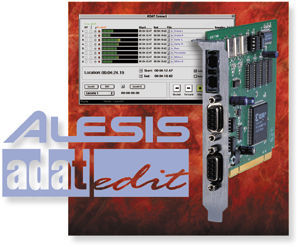
an adat interface card for mac os 9.. comes with software made by emagic
article :
http://www.soundonsound.com/sos/aug99/articles/alesisadat.htm http://www.sweetwater.com/publications/sweetnotes/sn-latesummer99/page11.htmlhttp://alesis.com/stuff/contentmgr/files/0/9d2b1fc3c579211a294dbd112724fbbe/file/adatedit_manual.pdf tascam pci-822 (Word clock OUT only)
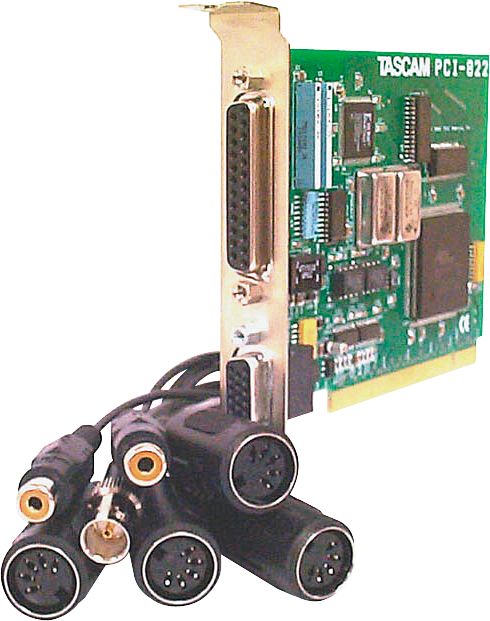 http://www.soundonsound.com/sos/may01/articles/tascampci_news.htm
http://www.soundonsound.com/sos/may01/articles/tascampci_news.htmThe PCI-822 is a PCI-based interface card that includes everything you need to send digital audio and MIDI signals to your computer for recording and sequencing. It includes a TASCAM 8-channel TDIF interface for DTRS recorders and compatible equipment, a stereo S/PDIF interface for DAT recorders and CD players, and 32 channels of MIDI I/O for keyboards, synth modules and mixer automation. The PCI-822 supports 16-, 20- and 24-bit audio as well as 44.1 and 48kHz sampling rates. Plus, it includes Nemesys' GigaSampler LE so you can take advantage of powerful software-based digital sampling. The PCI-822 is also compatible with most digital audio and sequencing software applications, and can be installed to both Mac and PC computers. If you're using a TASCAM modular digital multitrack and want to get into the power of nonlinear hard disk recording and editing, the PCI-822 is the affordable, easy-to-use solution.
driver:
http://tascam.com/content/downloads/products/298/PCI-822_Mac_Installer_v106.hqx8-ch TDIF digital i/o S/PDIF, 2x2 MIDI, word clock
Lynx One (1998) (word clock out only)
 http://www.lynxstudio.com/product_detail.asp?i=7
http://www.lynxstudio.com/product_detail.asp?i=7connects via pci | 6 in out | 2 midi i/o | word clock out
manual:
http://www.lynxstudio.com/nav/getFile.asp?i=8&t=productfile

